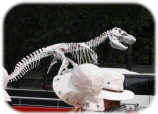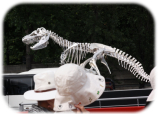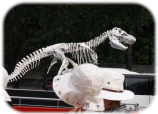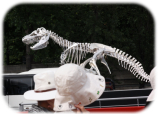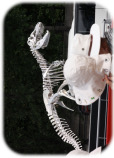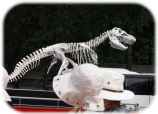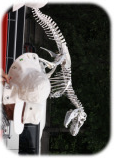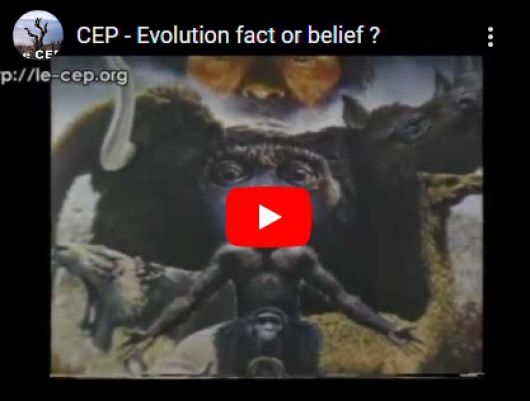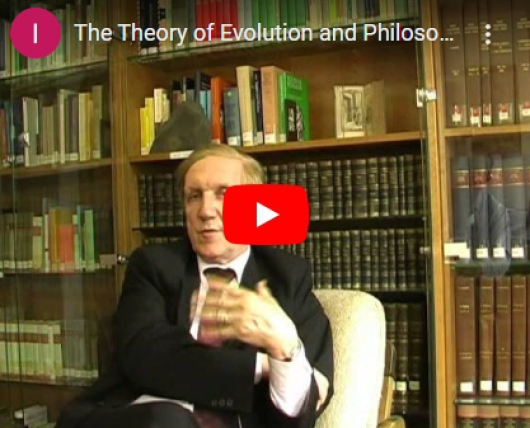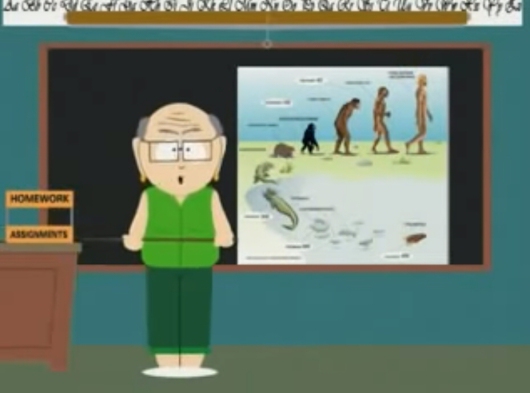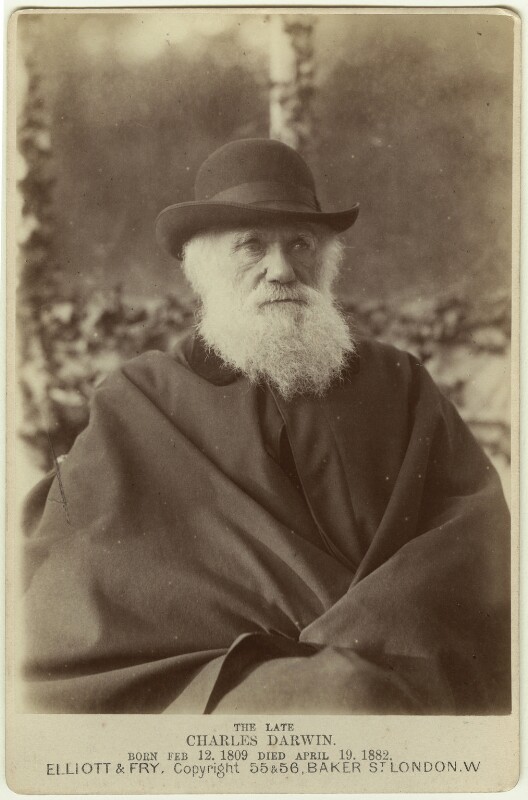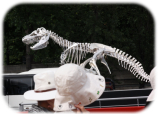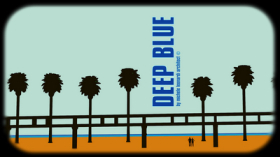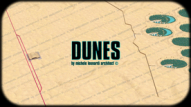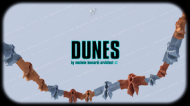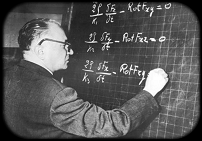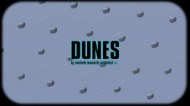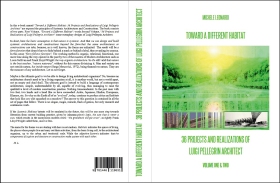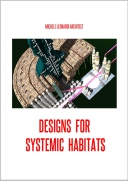EVOLUTION?
OR INVOLUTION
OF
AN IDEA?
AN ANSWER, MISTER W-REX, THANKS:
FROM THE STONE TO THE BANANA,
FROM BANANA TO MONKEY,
FROM MONKEY TO DARWIN:
MAGIC!
AND...
CAN YOU SHOW ME HOW YOU DO IT
BY MEANS OF AN EXPERIMENT?
NO, IT'S TAKING TOO MUCH TIME.
GENIUS! BUT HOW MUCH TOO MUCH TIME?
A BILLION YEARS, ONE MILLION, 100,000?
I SAID TOO MUCH TIME AND STOP!
BESIDES THE MUTATIONS ARE RANDOM AND BY JUMPS!
DRAGON! YOU KNOW ONE MORE THAN THE DEVIL!
HOWEVER NOW YOU SKIP THE MEAL
AND YOU GO DO RESEARCH ELSEWHERE,
BUT LOOKING FOR A NEW JOB.
DENIER! MUSEUMS ARE FULL OF EVIDENCES!
WHICH EVIDENCES? THE PUPPETS AND DRAWINGS
FROM MONKEY TO MAN? NEXT TO REAL FOSSILS?
YOU, CREATIONIST!
CREATIONIST IS YOU MOTHER WHO GAVE BIRTH YOU
IN A EGG.
HERE NO ONE TELLS YOU THAT IF EVOLUTIONISM ISN'T CLEAR, THEN CREATIONISM IS SCIENTIFICALLY TRUE.
STOP!
YOU, HEATER OF THE PLANET!!
OKAY, BUT NOW YOU GO HEAT CHAIRS
ELSEWHERE.
An original Introduction
by Michele Leonardi © 2022,
starring:
the Windbagus Rex,
in one of its evolutions.
Evolution: fact or belief ?
"Evolution: Science or belief?", documentary by "Le CEP-Centre d'Etudes et de perspective sur la science" (documentary without precise dating, period ca. 1996-2004). Speeches by:
- Prof. Roberto Fondi (1943), paleontologist, Department of Natural Sciences University of Siena.
- Prof. Giuseppe Sermonti (1925-2018), geneticist, molecular biologist, biochemist.
- Guy Berthault, sedimentologist.
- Prof. Edward Boudreau, professor of chemistry at the University of New Orleans.
- Prof. Maciej Marian Giertych (1936), dendrologist, Polish Academy of Science.
Rocks, by Guy Berthault
The Theory of Evolution and Philosophy
Theory of Evolution by Mr Garrison - SOUTH PARK
BIBLIOGRAPHY
Giuseppe Sermonti: "Why Is a Fly Not a Horse?", Discovery Institute, Seattle, 2005.
This book's Italian title, Dimenticare Darwin, means "Forget Darwin," and its prologue bears the title "Evolution is dead!" The author, Dr. Giuseppe Sermonti, is a respected Italian biologist who boldly shatters the myth that all critics of Darwinian evolution are American religious fundamentalists. This delightful little book is loaded with scientific facts that aren't taught in standard biology classes, but it is also full of history and poetry. Why is a Fly Not a Horse? does not have all the answers, but it asks many of the right questions-in a style that is both entertaining and inspiring. Giuseppe Sermonti is retired Professor of Genetics at the University of Perugia. He discovered genetic recombination in antibiotic-producing Penicillium and Streptomyces and was Vice President at the XIV International Congress of Genetics (Moscow, 1980). Sermonti is Chief Editor of Rivista di Biologia/Biology Forum, one of the oldest still-published biology journals in the world, and he has published seven other books, including Dopo Darwin (After Darwin), with R. Fondi (1980-1984).
= = =
Main principles of Sedimentology: excerpt from Experiments and Videos, and Papers, on Sedimentology.fr , 2022, by Guy Berthault:
Lalomov, A.: REPORT of researches of 2018 “Orogenesis of Alpine-Himalayan Folded Belt on the base of the researches of Crimean Mountain/Orogen System: geological history and reconstruction of hydrodynamic conditions”.
Dilly, R., Berthault, G.: “Orogenesis: Cause of sedimentary formations” – The Russian Academy of Sciences scientific Council on Lithology and Minerals in Sedimentary Formations – VIII All-Russian Lithological Meeting (Moscow, 27-30 October 2015), Tome II, pp. 162-164.
Berthault, G.: “Orogenesis: Cause of sedimentary formations” – Kazan Golovkinsy Stratigraphic Meeting, 2014, pp.19-20.
Lalomov, A., Berthault G., Tugarova, M., Isotov V., Sitdikova L.: “Reconstruction of sedimentary conditions of Middle Permian Kama-Ural basin studied by N.A. Golovkinsky” – Kazan Golovkinsy Stratigraphic Meeting, 2014, pp.53-54.
Berthault, G. : “Orogenesis: cause of sedimentary formations” – “Open Journal of Geology“ ISSN 2161-7570.Vol 3, Number 28, April 2013.
Berthault G. : “Towards a Refoundation of Historical Geology” – “Georesources” 1(12) 2012, p.38, 39.
Berthault, G., Lalomov, A. V. and Tugarova, M. A. : “Reconstruction of paleolithodynamic formation conditions of Cambrian-Ordovician sandstones in the Northwestern Russian platform” – “Lithology and Mineral Resources, 2011, Volume 46, Number 1, 60-70” (Springer Publishing site).
Berthault, G., Veksler A.B., Donenberg V.M. , Lalomov A. : “RESEARCH on EROSION OF CONSOLIDATED and semi-consolidated SOILS BY HIGH SPEED WATER FLOW” Izvestia.VNIIG., 2010, Vol. 257, pp.10-22. – (Russian original.).
Lalomov, A. : “Reconstruction of Paleohydrodynamic Conditions during the Formation of Upper Jurassic Conglomerates of the Crimean Peninsula”, Lithology and Mineral Resources, 2007, Vol. 42, No. 3, pp. 268–280.
Berthault, G : “Sedimentological Interpretation of the Tonto Group Stratigraphy (Grand Canyon Colorado River)” , Lithology and Mineral Resources 2004, Vol. 39, No 5. October 2004.
Berthault G., “Analysis of Main Principles of Stratigraphy on the Basis of Experimental Data”, Litol.Polezn.Iskop.2002, vol 37, no.5,pp 509-515 (Lithology and Mineral resources 2002 (fac-similé) (Engl.Transl.), vol.37, no.5, pp442-446), Journal of the Academy of Sciences of Russia.
Julien, P.Y., Lan, Y., and Berthault, G., “Experiments on Stratification of Heterogeneous Sand Mixtures”, Bulletin Société Géologique de France, 1993, vol. 164, no. 5, pp. 649–660.
Berthault, G., “Sedimentation of a Heterogranular Mixture. Experimental Lamination in Still and Running Water”, Compte rendu de l’Académie des Sciences 1988, vol. 306, Serie II, pp. 717–724.
Berthault, G., “Sedimentologie: Expériences sur la lamination des sédiments par granoclassement périodique postérieur au dépôt. Contribution a l’explication de la lamination dans nombre de sédiments et de roches sédimentaires”, Compte rendu de l’Académie des Sciences de Paris 1986 , vol. 303, Ser., 2, no. 17, pp. 1569-1574.
= = =
Richard Milton: "Shattering the Myths of Darwinism: A rational criticism of evolution theory", 1997.
Compelling evidence that the most important assumptions on which Darwinism rests are wrong.
The controversial best-seller that sent Oxford University and Nature magazine into a frenzy has at last come to the United States. Shattering the Myths of Darwinism exposes the gaping holes in an ideology that has reigned unchallenged over the scientific world for a century. Darwinism is considered to be hard fact, the only acceptable explanation for the formation of life on Earth, but with keen insight and objectivity Richard Milton reveals that the theory totters atop a shambles of outdated and circumstantial evidence that in any other field would have been questioned long ago.
Sticking to the facts at hand and tackling a vast array of topics, Shattering the Myths of Darwinism offers compelling evidence that the theory of evolution has become an act of faith rather than a functioning science, and that not until the scientific method is applied to it and the right questions are asked will we ever get the true answers to the mystery of life on Earth.
H. Clay Gorton: "The Demise of Darwinism: The Rise and Fall of Darwin's Theory of Evolution", 2012.
The controversy between Creationism and the Theory of Evolution has continued to boil since the time of Sir Issac Newton. A true revolution in scientific thinking to discard current theories for a new world view is now underway! The Demise of Darwinism points out the glaring inconsistencies in Darwin's theory, identifies outstanding evidence in support of catastrophism and helps decisive thinkers develop a critical eye regarding the theories of the human race.
J. Scott Turner: "Purpose and Desire: What makes something "alive" and why modern darwinism has failed to explain it", 2017.
A professor, biologist, and physiologist argues that modern Darwinism’s materialist and mechanistic biases have led to a scientific dead end, unable to define what life is—and only an openness to the qualities of "purpose and desire" will move the field forward.
Scott Turner contends: "To be scientists, we force ourselves into a Hobson’s choice on the matter: accept intentionality and purposefulness as real attributes of life, which disqualifies you as a scientist; or become a scientist and dismiss life’s distinctive quality from your thinking. I have come to believe that this choice actually stands in the way of our having a fully coherent theory of life."
Growing research shows that life's most distinctive quality, shared by all living things, is purpose and desire: maintain homeostasis to sustain life. In Purpose and Desire, Turner draws on the work of Claude Bernard, a contemporary of Darwin revered among physiologists as the founder of experimental medicine, to build on Bernard’s "dangerous idea" of vitalism, which seeks to identify what makes "life" a unique phenomenon of nature. To further its quest to achieve a fuller understanding of life, Turner argues, science must move beyond strictly accepted measures that consider only the mechanics of nature.
A thoughtful appeal to widen our perspective of biology that is grounded in scientific evidence, Purpose and Desire helps us bridge the ideological evolutionary divide.
Portrait of Charles Darwin by Elliott & Fry, 29 November 1881,
by courtesy of National Portrait Gallery in London © NPG x5938.
Criticism and the search for truth, it's okay,
but it is forbidden to demonize Charles Darwin.
Stephen C. Meyer and Paul A. Nelson: "Explore Evolution: The arguments for and against neo-darwinism", 2013.
The purpose of Explore Evolution is to examine the scientific controversy about Darwin's theory, and in particular, the contemporary version of the theory known as neo-Darwinism. Whether you are a teacher, a student, or a parent, this book will help you understand what Darwin's theory of evolution is, why many scientists find it persuasive, and why other scientists question the theory or some key aspects of it. Sometimes, scientists find that the same evidence can be explained in more than one way. When there are competing theories, reasonable people can (and do) disagree about which theory best explains the evidence. Furthermore, in the historical sciences, neither side can directly verify its claims about past events. Fortunately, even though we can't directly verify these claims, we can test them. How? First, we gather as much evidence as possible and look at it carefully. Then, we compare the competing theories in light of how well they explain the evidence. Looking at the evidence and comparing the competing explanations will provide the most reliable path to discovering which theory, if any, gives the best account of the evidence at hand. In science, it is ultimately the evidence-and all of the evidence-that should tell us which theory offers the best explanation. This book will help you explore that evidence, and we hope it.
Phillip E. Johnson and Denis O. Lamoureux: "Darwinism Defeated? The Johnson-Lamoureux Debate on Biological Origins", 1999.
Michael J. Behe: "Darwin's Black Box: The Biochemical Challenge to Evolution", 2006.
Darwin’s Black Box helped to launch the Intelligent Design movement: the argument that nature exhibits evidence of design, beyond Darwinian randomness. Today, with the movement stronger than ever, Michael J. Behe updates the book with an important new Afterword on the state of the debate.
Michael J. Behe: "The Edge of Evolution: The Search for the Limits of Darwinism", 2008.
When Michael J. Behe's first book, Darwin's Black Box, was published in 1996, it launched the intelligent design movement. Critics howled, yet hundreds of thousands of readers -- and a growing number of scientists -- were intrigued by Behe's claim that Darwinism could not explain the complex machinery of the cell.
Now, in his long-awaited follow-up, Behe presents far more than a challenge to Darwinism: He presents the evidence of the genetics revolution -- the first direct evidence of nature's mutational pathways -- to radically redefine the debate about Darwinism.
How much of life does Darwin's theory explain? Most scientists believe it accounts for everything from the machinery of the cell to the history of life on earth. Darwin's ideas have been applied to law, culture, and politics.
But Darwin's theory has been proven only in one sense: There is little question that all species on earth descended from a common ancestor. Overwhelming anatomical, genetic, and fossil evidence exists for that claim. But the crucial question remains: How did it happen? Darwin's proposed mechanism -- random mutation and natural selection -- has been accepted largely as a matter of faith and deduction or, at best, circumstantial evidence. Only now, thanks to genetics, does science allow us to seek direct evidence. The genomes of many organisms have been sequenced, and the machinery of the cell has been analyzed in great detail. The evolutionary responses of microorganisms to antibiotics and humans to parasitic infections have been traced over tens of thousands of generations.
As a result, for the first time in history Darwin's theory can be rigorously evaluated. The results are shocking. Although it can explain marginal changes in evolutionary history, random mutation and natural selection explain very little of the basic machinery of life. The "edge" of evolution, a line that defines the border between random and nonrandom mutation, lies very far from where Darwin pointed. Behe argues convincingly that most of the mutations that have defined the history of life on earth have been nonrandom.
Although it will be controversial and stunning, this finding actually fits a general pattern discovered by other branches of science in recent decades: The universe as a whole was fine-tuned for life. From physics to cosmology to chemistry to biology, life on earth stands revealed as depending upon an endless series of unlikely events. The clear conclusion: The universe was designed for life.
Mark My Words: "The Scientific Method: Proves that the Theory of Evolution Is False", 2020.
Documenting my current understanding of the Scientific Method and demonstrating how I use the Scientific Method in my pursuit of THE TRUTH.I love studying methodology, or the different versions of the Scientific Method. There are many different Scientific Methods. Observation is my favorite scientific method. Through observation and experience, we can identify and falsify the lies in science. Through observation, we can go directly to “knowing the truth”. One of my specialties is using the different Scientific Methods to falsify the deceptions and the lies in science, starting with the Theory of Evolution. If you are intelligent enough and creative enough, all of the different Scientific Methods can be used to falsify the Theory of Evolution. You just have to be willing to give it some study and thought.The Scientific Methods can be used to prove theories false! It’s called “falsifying” a theory or “negating the consequent”. Our scientists haven’t yet discovered the most powerful and most reliable version of the Scientific Method – the negating the consequent version of the Scientific Method. They don’t know what it is or how to use it. The version of the scientific method that our scientists currently use has a couple of serious flaws or logic fallacies built into it; and, our scientists don’t even know it because they have never studied the Philosophy of Science or the scientific methods.In this book, I used Science and the Scientific Method to falsify Darwinism, Materialism, Naturalism, and the Theory of Evolution – in a number of different ways. It’s easy to do once you know how, and a great deal of fun too. I have never seen anybody do this before; and, I wish that I would have known how to falsify the Theory of Evolution forty years ago. It's so obvious, I wonder why nobody ever thought of it before now.The purpose of the Scientific Method is to help us to find THE TRUTH, through a preponderance of the evidence, and a process of elimination. We find the Truth in Science by identifying and eliminating everything that is false. If you successfully identify and eliminate everything that is false, then ONLY the truth will remain. This is Logic 101. The truths that remain after you have eliminated everything that is false ends up being the things that have been experienced and observed by someone, somewhere, sometime. If a phenomenon or theory has never been experienced nor observed by anyone, not even God, then it can’t possibly be real or true.The Scientific Method has no value to us if we use it to convince ourselves that a LIE is TRUE.The Scientific Methods prove that the Theory of Evolution and the Second Law of Thermodynamics are false. That’s what I discovered during my Pursuit of the True Reality of All Things, and during my study and usage of the Scientific Method. It’s not a gimmick. I actually use the Scientific Method and negating the consequent to falsify Materialism, Naturalism, Darwinism, Nihilism, Atheism, and their derivatives. It’s easy to do once you know how. I’m no longer afraid to have this conversation because I’m no longer a materialist, naturalist, nihilist, or atheist.Collectively, my books stand as a powerful witness that by 2020, the Truths in Science can now be found and known if we are willing to give up the deceptions and the lies. I now know what everything is and how it works. I couldn’t say that with complete confidence before 2020, but now I can. I’m running out of questions to ask that need to be answered. By allowing quantum mechanics and conserved quanta in to play, we can literally explain everything that comes our way. We no longer have to be enslaved to the deceptions and the lies if we don’t want to be.This is one of the most powerful and comprehensive books about the Scientific Method and the Philosophy of Science that has ever been designed and made. Buy it, read it, and see if you agree.
Whitley R.P. Kaufman: "Human Nature and the Limits of Darwinism", 2016.
This book compares two competing theories of human nature: the more traditional theory espoused in different forms by centuries of western philosophy and the newer, Darwinian model. In the traditional view, the human being is a hybrid being, with a lower, animal nature and a higher, rational or “spiritual” component. The competing Darwinian account does away with the idea of a higher nature and attempts to provide a complete reduction of human nature to the evolutionary goals of survival and reproduction. Whitley Kaufman presents the case that the traditional conception, regardless of one's religious views or other beliefs, provides a superior account of human nature and culture. We are animals, but we are also rational animals.
Kaufman explores the most fundamental philosophical questions as they relate to this debate over human nature—for example: Is free will an illusion? Is morality a product of evolution, with no objective basis? Is reason merely a tool for promoting reproductive success? Is art an adaptation for attracting mates? Is there any higher meaning or purpose to human life? Human Nature and the Limits of Darwinism aims to assess the competing views of human nature and present a clear account of the issues on this most pressing of questions. It engages in a close analysis of the numerous recent attempts to explain all human aims in terms of Darwinian processes and presents the arguments in support of the traditional conception of human nature.
Jeffrey K Lyons : "Evolution Myths: A Critical View of neo-Darwinism", 2018.
Today, evolutionary theory is ubiquitous in our secular education systems. This book is a critical view of neo-Darwinism, which is the dominant dogma throughout secular higher education and K-12 public education. The criticisms of neo-Darwinism cited in this book are from various overlapping groups of: scientists, atheists, philosophers and university professors. If you are looking for a resource that will give you sound arguments and facts, that will aid you in thinking critically about Darwinism; this is the resource for you.
Evolution is no longer a biological theory. It permeates the natural sciences, social sciences and philosophy. It has become a meta-theory. Whenever scientific data are absent, both natural and social scientists resort to narrative as a super glue. Evolution is open to criticism!
You will discover the following: Who popularized the term evolution and why Darwin opposed the term evolution. How many times Darwin referred to the Creator in The Origin of Species. What world famous scientist believed DNA was not naturally caused. The Three Barriers to Life, that evolution cannot explain. Proof that life cannot be the result of random forces. How catastrophic events wiped out about 90% of life on Earth. Who are some of the leading scientists and philosophers that dare to question evolution. Chapter summaries will guide you through the topics. Hundreds of scientific sources are cited for further research.
Michael J. Behe: "Darwin Devolves: The New Science About DNA That Challenges Evolution", 2020.
The scientist who has been dubbed the “Father of Intelligent Design” and author of the groundbreaking book Darwin’s Black Box contends that recent scientific discoveries further disprove Darwinism and strengthen the case for an intelligent creator.
In his controversial bestseller Darwin’s Black Box, biochemist Michael Behe challenged Darwin’s theory of evolution, arguing that science itself has proven that intelligent design is a better explanation for the origin of life. In Darwin Devolves, Behe advances his argument, presenting new research that offers a startling reconsideration of how Darwin’s mechanism works, weakening the theory’s validity even more.
A system of natural selection acting on random mutation, evolution can help make something look and act differently. But evolution never creates something organically. Behe contends that Darwinism actually works by a process of devolution—damaging cells in DNA in order to create something new at the lowest biological levels. This is important, he makes clear, because it shows the Darwinian process cannot explain the creation of life itself. “A process that so easily tears down sophisticated machinery is not one which will build complex, functional systems,” he writes.
In addition to disputing the methodology of Darwinism and how it conflicts with the concept of creation, Behe reveals that what makes Intelligent Design unique—and right—is that it acknowledges causation. Evolution proposes that organisms living today are descended with modification from organisms that lived in the distant past. But Intelligent Design goes a step further asking, what caused such astounding changes to take place? What is the reason or mechanism for evolution? For Behe, this is what makes Intelligent Design so important.
Stephen C. Meyer: "Darwin's Doubt: The Explosive Origin of Animal Life and the Case for Intelligent Design", 2014.
When Charles Darwin finished The Origin of Species, he thought that he had explained every clue, but one. Though his theory could explain many facts, Darwin knew that there was a significant event in the history of life that his theory did not explain. During this event, the “Cambrian explosion,” many animals suddenly appeared in the fossil record without apparent ancestors in earlier layers of rock.
In Darwin’s Doubt, Stephen C. Meyer tells the story of the mystery surrounding this explosion of animal life—a mystery that has intensified, not only because the expected ancestors of these animals have not been found, but because scientists have learned more about what it takes to construct an animal. During the last half century, biologists have come to appreciate the central importance of biological information—stored in DNA and elsewhere in cells—to building animal forms.
Expanding on the compelling case he presented in his last book, Signature in the Cell, Meyer argues that the origin of this information, as well as other mysterious features of the Cambrian event, are best explained by intelligent design, rather than purely undirected evolutionary processes.
Robert B. Laughlin: "The Crime of Reason: And the Closing of the Scientific Mind", 2012.
We all agree that the free flow of ideas is essential to creativity. And we like to believe that in our modern, technological world, information is more freely available and flows faster than ever before. But according to Nobel Laureate Robert Laughlin, acquiring information is becoming a danger or even a crime. Increasingly, the really valuable information is private property or a state secret, with the result that it is now easy for a flash of insight, entirely innocently, to infringe a patent or threaten national security. The public pays little attention because this vital information is “technical”—but, Laughlin argues, information is often labeled technical so it can be sequestered, not sequestered because it's technical. The increasing restrictions on information in such fields as cryptography, biotechnology, and computer software design are creating a new Dark Age: a time characterized not by light and truth but by disinformation and ignorance. Thus we find ourselves dealing more and more with the Crime of Reason, the antisocial and sometimes outright illegal nature of certain intellectual activities.
Rupert Sheldrake: "The Science Delusion. Freeing The Spirit Of Enquiry", 2012.
Freeing the Spirit of EnquiryThe science delusion is the belief that science already understands the nature of reality. The fundamental questions are answered, leaving only the details to be filled in. In this book (published in the US as Science Set Free), Dr Rupert Sheldrake, one of the world's most innovative scientists, shows that science is being constricted by assumptions that have hardened into dogmas. The 'scientific worldview' has become a belief system. All reality is material or physical. The world is a machine, made up of dead matter. Nature is purposeless. Consciousness is nothing but the physical activity of the brain. Free will is an illusion. God exists only as an idea in human minds, imprisoned within our skulls. Sheldrake examines these dogmas scientifically, and shows persuasively that science would be better off without them: freer, more interesting, and more fun. In The God Delusion Richard Dawkins used science to bash God, but here Rupert Sheldrake shows that Dawkins' understanding of what science can do is old-fashioned and itself a delusion. 'Rupert Sheldrake does science, humanity and the world at large a considerable favour.' The Independent 'Certainly we need to accept the limitations of much current dogma and keep our minds open as we reasonably can. Sheldrake may help us do so through this well-written, challenging and always interesting book.' Financial Times
Jonathan Wells: "Icons of Evolution: Science or Myth? Why Much of What We Teach About Evolution is Wrong", 338 pages, Regnery Publishing, Washington, DC, USA, 2002.
How would you react if told that you and your children have been lied to in science lessons at school and university? Yet this is exactly what has been happening for decades, as Icons of Evolution' demonstrates. The author, a Berkeley Ph.D in Biology, is not a creationist, but his book describes many serious misrepresentations of facts commonly found in biology textbooks, which are used to perpetuate belief in evolution. The main part of the book describes ten of these icons', devoting one chapter to each, and shows what is wrong with them in the light of published scientific evidence. The chapters are all fairly brief, and each is divided into short sections, to make the material easier to assimilate. The author's thesis is amply documented with 71 pages of research notes at the end of the book.
Marco Pizzuti (in Italian): "Scoperte scientifiche non autorizzate - Oltre la verità ufficiale" (Unauthorized scientific discoveries: Beyond the official truth), Edizioni Il Punto d'Incontro, Vicenza, Italy, 2011.
"Scoperte scientifiche non autorizzate" raises many disturbing questions: it traces the story of Nikola Tesla, an extraordinary yet misunderstood scientist whose more than 700 revolutionary patents laid the technological foundations of modern society; it tells us about many other "rebel scientists" condemned to oblivion by the scientific establishment; and it sheds light on one of the most widespread myths of our time, "free science in the service of all", showing how in reality it is the global financial elite that consciously manipulates technological progress. Marco Pizzuti's book is an essay, grounded in true facts and stories, that has nothing to envy from the most shocking of novels and gives us a glimpse of how much better our world could be if only it were truly free.
Criticism and the search for truth, it is okay.
But it is forbidden to demonize Charles Darwin, his work,
and his genuine search of truth.

